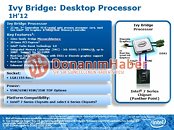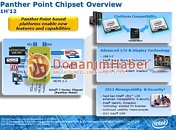Tuesday, April 12th 2011

Intel Ivy Bridge Feature Set Detailed
Some time in the first half of 2012, Intel will release its next generation of desktop processors for the LGA1155 socket, based on the new Ivy Bridge silicon. Ivy Bridge is a 22 nanometer die-shrink of Sandy Bridge, with a few features added/improved. Ivy Bridge's smaller die size will allow for increased clock speeds and reduced production costs. A presentation was leaked to the press, which reveals quite a bit about the new chips. To begin with, Ivy Bridge processors are seamlessly compatible with existing LGA1155 platforms, and "Cougar Point" P67, H67, H61, Z68, chipsets, although it will come with its own 7-series chipset.
For the most part, Ivy Bridge is identical to Sandy Bridge, being an optical shrink from existing 32 nm to 22 nm. It will feature a new dual-channel DDR3 memory controller with official support for DRAM speeds of up to DDR3-1600 MHz. There's the usual PCI-Express 2.0 x16 hub that can drive up to two discrete graphics cards with electrical x8 connections. The integrated graphics controller will face an overhaul, it will be DirectX 11 compliant. It will also support the next version of Intel QuickSync GPU-accelerated video encoding technology. Turbo Boost 2.0 will be carried forward. TDP ranges in the usual 95/65/45/35W options.Moving on, the next slide shows how Sandy Bridge, Ivy Bridge processors; and Cougar Point, Panther Point chipsets are seamlessly compatible with each other. Ivy Bridge processors can run on existing 6-series chipsets, Sandy Bridge should be able to run on Panther Point 7-series chipsets as well. The incentive in Panther Point chipset, however, is that it will feature a newer FDI interface that will support up to three displays running simultaneously; and that it will feature an integrated USB 3.0 controller. USB 3.0 will be implemented in a similar fashion as SATA 6 Gb/s on Cougar point, only some, not all USB ports will be SuperSpeed ports.
Source:
DonanimHaber
For the most part, Ivy Bridge is identical to Sandy Bridge, being an optical shrink from existing 32 nm to 22 nm. It will feature a new dual-channel DDR3 memory controller with official support for DRAM speeds of up to DDR3-1600 MHz. There's the usual PCI-Express 2.0 x16 hub that can drive up to two discrete graphics cards with electrical x8 connections. The integrated graphics controller will face an overhaul, it will be DirectX 11 compliant. It will also support the next version of Intel QuickSync GPU-accelerated video encoding technology. Turbo Boost 2.0 will be carried forward. TDP ranges in the usual 95/65/45/35W options.Moving on, the next slide shows how Sandy Bridge, Ivy Bridge processors; and Cougar Point, Panther Point chipsets are seamlessly compatible with each other. Ivy Bridge processors can run on existing 6-series chipsets, Sandy Bridge should be able to run on Panther Point 7-series chipsets as well. The incentive in Panther Point chipset, however, is that it will feature a newer FDI interface that will support up to three displays running simultaneously; and that it will feature an integrated USB 3.0 controller. USB 3.0 will be implemented in a similar fashion as SATA 6 Gb/s on Cougar point, only some, not all USB ports will be SuperSpeed ports.



30 Comments on Intel Ivy Bridge Feature Set Detailed
- Ivy Bridge will be 1155 compatible.
- Panther Point will also be available, but the only upgrade is integrated USB 3.0. (Seriously? P67-P77 and the only difference in USB 3.0 which we already have..?)
- No mention of PCIe 3.0.
So, I guess next year we'll have to consider 32nm Sandy Bridge-EE or 22nm Ivy Bridge.
Personally, if the IV CPUs have a 5.0Ghz wall as well, they'll be slightly pointless.
All up this sounds more appealing (at this stage) than the proposed x series chipset and CPU for my next upgrade
Ivy Bridge will feature PCI Express 3.0, but only the lanes coming out of the CPU, not the ones from the chipset.
So will the new CPU's work on current mobo's or not ?
Nehalem was a Tick
Sandy Bridge was the Tock
Ivy should be a Tick?
Sandy Bridge is Tick (although, not a big architectural jump over Nehalem, it is still a new architecture) and Ivy will be SB's Tock (die shrink)
Clarkdale - Tock 32nm
Sandy Bridge - Tick 32nm
Ivy Bridge - Tock 22nm
:)
I was right. No, they will not get new SB CPUs, as the new CPUs are valled Ivy Bridge.
And if you'd read my post just a little bit further you'd have the answer to your question.
And I'm sorry I cannot deduct your answers if you cannot understand the questions but the fact is that its not obvious for everybody that all current 1155 stuff will be ivy compatible and Nesters post above proves my doubt in it.